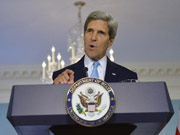"Pure pursuit of a high growth rate is not conducive to economic transformation. If the economy goes beyond the upper limit, China should rethink its policies," said Zhang Yansheng, secretary general of the Academic Committee of the National Development and Reform Commission, adding that a range between 7 to 7.5 percent would be ideal for China's balancing act.
In Wednesday's speech, Li said China's current growth is at a "medium to high rate," recognizing that China has entered a new stage divorced from the double-digit expansion of the past decade.
The focus now should turn from headline growth to other detailed economic indicators measuring quality and efficiency, Zhang said, arguing silver linings can be found in last year's growth, even though the economy is at a 13-year low.
He cited fast employment growth, the greater role of consumption, and steady growth of the service sector as evidence of a gradually transforming economy.
At the ongoing Summer Davos Forum, Dr. Hans-Paul Burkner, chairman of the Boston Consulting Group, said China needs more balanced growth between the different parts of society and more consideration for people's well-being, such as health, environment and services.
"In general, it is about opening up the economy further, so that there are more opportunities for private initiatives. Given the enormous talents China has, this is going to create further strong momentum for the whole country and economy," said Burkner.
China's economic growth eased to 7.5 percent in the second quarter, down from 7.7 percent in the first three months.
Instead of initiating a massive stimulus program to lift the economy, authorities are moving cautiously by speeding up shantytown renovation, accelerating railway and infrastructure investment, and reducing taxes for small businesses to steady growth while driving though reforms.
The efforts have gradually worked, Li said, citing August's improving economic indicators, such as the Purchasing Managers' Index, industrial profits and power consumption, as evidence of a firming economy.
"Such momentum of steady progress gives us confidence that we can meet the economic and social development goals set for the year," Li said.
Zhang Xiaojing, an economist with the Chinese Academy of Social Sciences, raised caution over underlying risks, including possible capital outflows triggered by U.S. tapering of quantitative easing and the financial hazards of China's de-leveraging process.
"The biggest challenge for China is resolving financial risks while driving through reforms," he said, naming local government debts and shadow banking as the most concerning.
"Economic upgrading is a long-term task that requires coordinated efforts at various levels, and we hope the upcoming Third Plenary Session of the 18th Communist Party of China Central Committee will offer more detailed reform plans," he added.
 |

 Kerry says U.S. to make own decision on attack on Syria
Kerry says U.S. to make own decision on attack on Syria China's weekly story (2013.8.24 - 8.30)
China's weekly story (2013.8.24 - 8.30) Highlights of MAKS 2013 Int'l Aviation and Space Show
Highlights of MAKS 2013 Int'l Aviation and Space Show  Stunt performance on floating bamboo stick
Stunt performance on floating bamboo stick Home prices keep rising in August
Home prices keep rising in August 18-meter-high Rubber Duck ready to meet Beijingers
18-meter-high Rubber Duck ready to meet Beijingers Reveal the South Korean beauty production line
Reveal the South Korean beauty production line Puppet Manchurian Palace Museum in China's Jilin
Puppet Manchurian Palace Museum in China's Jilin
Day|Week|Month